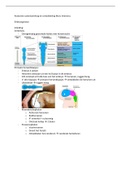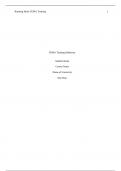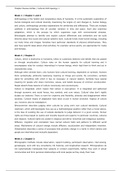Embryogenese
Inleiding:
Ventrikels
- Onregelmatig gevormde holtes met hersenvocht
Primaire hersenblaasjes:
- Embryo 4 weken
- Hersenen ontstaan uit een hol buisje in de embryo
- CZS ontstaat uit holle buis van het embryo → hersenen, ruggenmerg.
- 1e drie blaasjes → primaire hersenblaasjes → ontwikkelen de hersenen uit
- Uitsteeksel → ruggen merg
-
- Rhombenchephalon
o Achterste hersenen
o Ruithersenen
o 4e ventrikel = ruitvormig
o Ontstaat knikje → 2 delen
- Prosencephalon
o Voorhersenen
o Groeit het hardst
o Ontwikkelen het cerebrum → cerebrale hemisferen
,Secundaire hersenblaasjes
- Embryo 6 weken
- Prosencephalon in 2 delen
o Telencephalon
▪ Voorste gedeelte
▪ Groeit het hardst
▪ Laterale ventrikels
o Dienchephalon
▪ Derde ventrikel
▪ Toekomstige ogen
- Voorheen rhombenchephalon
o Knikje wordt het 4e ventrikel
o Metencephalon en myelenchepalon
- Mesenchephalon
o Aquaductus cerebri
-
Embryonale ontwikkeling ventrikels
- Telenchephalon
o Holleruimten worden laterale ventrikels
o Draait tijdens groeien → veranderd van vorm → holle ruimte vervormd tot
laterale ventrikels etc.
,Ontwikkeling
- De geleidelijke veranderingen van lichaamsdelen en fysiologische kenmerken
- Periode van bevruchting tot de volwassenheid
- Bestaat uit
o De deling en differentiatie van cellen
o Verandering waarbij anatomische structuren worden gevormd en gewijzigd.
- Begint bij:
o Embryonale ontwikkeling
o Foetale ontwikkeling tot de geboorte (9e week)
o Prenatale ontwikkeling (geboorte)
o Postnatale ontwikkeling (geboorte → volwassen)
Embryogenese
-
- 40 weken zwanger
- Ovulatie
o Folliculaire fase
▪ De periode waarin de follikel groeit
▪ In ovarium rijpt een eicel
▪ Elke maand 1 gerijpt
▪ Gele lichaam → hormonenproductie
▪ 1e tot 14e dag cyclus.
, ▪ Hypothalamus → hypofyse → follikelstimulerend hormoon door het
lichaam → ovaria → 1 oocyt → gaat groeien → komt in follikel te
zitten → blaasje zwelt op → vochtblaasje met eitje → eitje klaar →
schiet weg → ovulatie
▪
o Luteale fase
▪ Hormonen worden afgegeven vanuit het corpus luteum
▪ Cycli verschillen van 21 tot 40 dagen
▪ Cellen gaan specialiseren → gele lichaam
- Spermatogenese
o Zaadcel
o Testis
▪ Kronkels → productie zaadcellen
▪ Wand met buisjes houd witte bloedcellen tegen
• Bescherming cellen, cellen delen → miose, meiose →
spermacellen
o
- Bevruchting (1e gedeelte ontwikkeling)
o Dag 1
▪ Zaadcellen komen aan
▪ Zaadcel acrsoom knapt → brandt hierdoor een gat → cel gaat door
corona radiaten → komt bij de eicel





